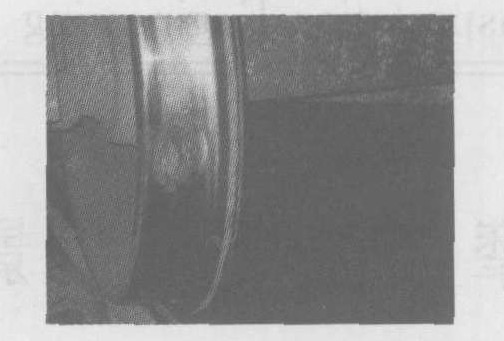Uneven surface effect on temperature distribution of wheel and rail contact
Article Text (Baidu Translation)
-
摘要: 为揭示轮轨表面破坏与摩擦温升的内在联系, 利用有限元和有限差分混合算法, 建立了轮轨滚动接触热耦合计算模型, 模拟轮轨滚动、滑动接触温升过程。模型中考虑了轮轨间非稳态热传导、与环境的热对流、热辐射, 针对轮轨光滑和不平顺两种接触表面情形, 分析了滚动、滑动工况下轮轨界面间的摩擦温升状态。计算结果表明轮轨表面不平顺能使经历短时间滑动的轮轨表面倾向于产生斑点状剥离, 长时间滑动与滚动工况下表面不平顺对温度场的影响可忽略, 滑动工况的温升较滚动工况的大。Abstract: In order to study the relation of the damaged surface and temperature resulted from wheel and rail friction, a heat coupling model of rolling and sliding of wheel and rail was put forward to calculate the temperature rise with a combination method of finite element method and finite difference method. In the model, the non-steady heat conduction between the contacting surfaces of wheel and rail, heat convection and heat radiation between wheel and rail and their ambient were tested. The effect of the surface unevenness of wheel and rail on the frictional temperature was analyzed in the rolling and pure sliding states of wheel on rail. The numerical results show that the surface uneveness of wheel and rail can lead to spalling in short sliding, its effect on the temperature rise be ignored in long sliding and rolling.
-
表 1 材料性能参数
Table 1. Material property parameters
参数 数值 车轮半径rw/mm 525 轮载P/kN 100 比热容c/[J· (kg·K)-1] 470 热传导率K/[W· (m·K)-1] 41 密度ρ/ (kg·m-3) 7 790 摩擦系数μ 0.3 泊松比v 0.3 杨氏模量E/ (N·mm-2) 2.07×105 环境温度T0/℃ 30 发射率e 0.3 注: 如无特殊说明, 本文中的计算均使用以上数据。 -
[1] Jergéus J, Odenmarck C, Lundén R, et al. Full-scale railway wheel flat experiments[J]. Journal of Rail Rapid Transit, 1999, 213(1): 1-13. https://www.cnki.com.cn/Article/CJFDTOTAL-JRYJ201911009.htm [2] Kennedy T C, Way C, Harder R F. Modeling of martensite formation in railcar wheels due to Hertzian wheel slides[A]. Proceeding of the 6th International Conference on Contact Mechanics and Wear of Rail/Wheel Systems[C]. Chalmers University Press, Sweden, 2003. [3] Hou K, Kalousek J, Lamba H S, et al. Wear and friction of wheel/rail materials for high adhesion locomotives[A]. Proceeding of the 12th International Congress on Wheelset[C]. China Railway Press, China, 1998. [4] Knothe K, Liebelt S. Determination of temperatrue for sliding contact with applications for wheel-rail systems[J]. Wear, 1995, 189(1): 91-99. https://www.cnki.com.cn/Article/CJFDTOTAL-JFXG202110005.htm [5] Martin E, Klaus K. A comparison of analytical and numerical methods for the calculation of temperature in wheel/rail contact[J]. Wear, 2002, 253(5): 498-508. https://www.cnki.com.cn/Article/CJFDTOTAL-ZGDC201511021.htm [6] Pei You-fu, Jin Yuan-sheng, Wen Shi-zhu. An FEM analysis of wheel/rail contact heat[J]. China Railway Science, 1996, 17 (4): 48-58. (in Chinese) https://www.cnki.com.cn/Article/CJFDTOTAL-ZGTS201405001.htm [7] Sun Qiong, Chen Ze-shen, Zang Qi-ji. On the contact temperature rise between wheel and rail and its numerical analysis [J]. China Railway Science, 1997, 18(4): 14-23. (in Chinese) https://www.cnki.com.cn/Article/CJFDTOTAL-ZGTS201501007.htm [8] Johan A, Birger K. Modelling of heat conduction and phase transformations during sliding of railway wheels[J]. Wear, 2002, 253(3): 291-300. https://www.cnki.com.cn/Article/CJFDTOTAL-JEXG201502005.htm [9] 金学松, 刘启跃. 轮轨摩擦学[M]. 北京: 中国铁道出版社, 2004. [10] 戴锅生. 传热学[M]. 北京: 高等教育出版社, 2001. -





 下载:
下载:










